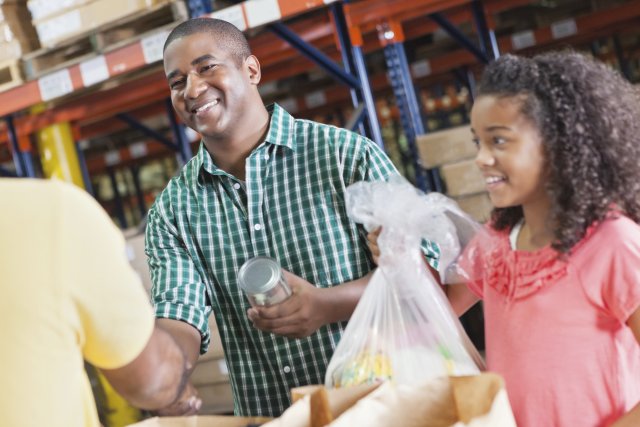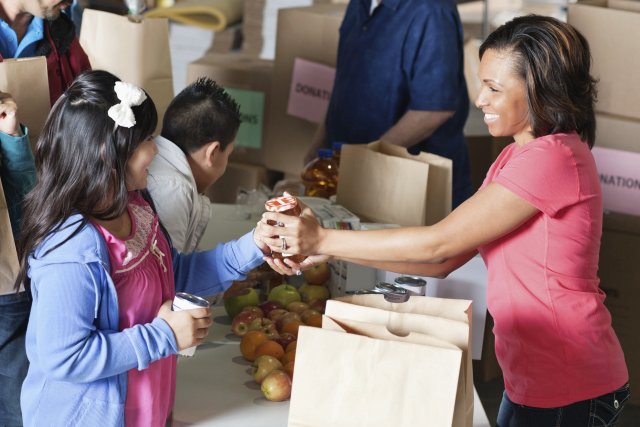Non Profit to Feed the Homeless With Restaurant Excess Food at the End of the Day
On this page:
- Basics
- How to Donate Food
- Sources of Statistics

Redistributing food to feed people is the second tier of EPA's Food Recovery Hierarchy. EPA estimates that in 2018, about 63 million tons of wasted food were generated in the United States1. While Americans dispose of millions of tons of food, the U.S. Department of Agriculture estimates that 10.5 percent of American households - about 13.7 million households - had difficulty providing enough food for all their members due to a lack of resources at some time during 2019.2 In many cases, the food tossed into our nation's landfills is wholesome, edible food.
We can be leaders in our communities by collecting unspoiled, healthy food and donating it to our neighbors in need. By donating food, we're feeding people, not landfills, supporting local communities, and saving all the resources that went into producing that food from going to waste.
Basics
Anyone Can Be a Food Donor
Large manufacturers, supermarket chains, wholesalers, farmers, food brokers, and organized community food drives typically give food to food banks. Restaurants, caterers, corporate dining rooms, hotels, and other food establishments promptly distribute perishable and prepared foods to hungry people in their communities. Many food banks and food rescue organizations will pick up food donations free of charge, saving donors time and money.
Legal Basics
Corporate donors are protected from liability under the Bill Emerson Good Samaritan Food Donation Act (PDF)(2 pp, 207K, About PDF). Under this Act, as long as the donor has not acted with negligence or intentional misconduct, the company is not liable for damage incurred as the result of illness. USDA's Frequently Asked Questions about the Bill Emerson Good Samaritan Food Donation Act (PDF)(3 pp, 240 K, About PDF) provides more information on the Act. Learn more from the Global Food Donation Policy Atlas' United States Legal Guide - Food Donation Law and Policy (PDF)(25 pp, 1.71MB, About PDF) and the University of Arkansas' Food Recovery – a legal guide (PDF)(12 pp, 8.44MB, About PDF).
Safety Basics
Many non-perishable and unspoiled perishable foods can be donated to local food banks, soup kitchens, pantries, and shelters if the transaction is managed properly. Check with your local food bank or food rescue operation to find out what items they will accept. Learn more about Food Safety Basics or contact your state or local health department for more information on how to safely donate food. More information on food safety can be found in Harvard Law School Food Law and Policy Clinic's Food Safety Regulations & Guidance for Food Donations: A Fifty-State Survey of State Practices (PDF)(38 pp, 1.24MB, About PDF).
Tax Benefits
There are potential tax benefits for companies that donate food. See Harvard Food Law and Policy Clinic's Federal Enhanced Tax Deduction for Food Donation, a Legal Guide for information on enhanced tax deductions available to businesses donating food.
How to Donate Food

Where to Donate
-
Food pantries, food banks and food rescue programs are available across the country to collect food and redistribute it to those in need.
-
Food banks are community-based, professional organizations that collect food from a variety of sources and save the food in warehouses. The food bank then distributes the food to hungry families and individuals through a variety of emergency food assistance agencies, such as soup kitchens, youth or senior centers, shelters and pantries. Most food banks tend to collect nonperishable foods such as canned goods because they can be stored for a longer time.
-
Food rescue organizations operate food rescue programming, which includes the retrieval of excess food from donors and/or the delivery of donated food directly to clients or to other organizations that redistribute food to clients. These organizations may also offer other programming, such as education/skills training and the repurposing of donated food into meals or other food products, etc., and many of them apply software solutions, like apps, to coordinate the redistribution of excess food by volunteers or other organizations.

Ideas for Increasing Food Donations in Your Community
-
Leverage your existing relationships with food banks to donate food after events.
-
Reach out to your local grocers, restaurants, venues and/or schools to suggest that they could donate wholesome food that will be wasted.
-
Create a schedule for pick-up of donated food from your organization or business on a weekly, biweekly or monthly basis.
-
Use donated food to feed the hungry or elderly of your community or for events held at your facility.
-
Become a volunteer for a food rescue organization to help transport food from donors to food recipient organizations!
-
Are you a faith-based organization? Check out the Food Stewards Toolkit to learn more about how your organization can reduce wasted food by modifying food purchases, donating, composting, getting others involved, and sharing your story.
Find Food Recipient Organizations
The following sites contain tools that allow users to search for food banks, pantries, soup kitchens and shelters that may be interested in accepting wholesome, excess food:
- Feeding America's Find Your Local Foodbank has a map of Feeding America member food banks. Some of these food banks might have a minimum donation size requirement. Feeding America also operates the Meal Connect app , which connects donors to local food banks.
- Sustainable America's Food Rescue Locator is a directory of organizations that rescue, glean, transport, prepare, and distribute food to the needy in their communities.
- AmpleHarvest.org allows you to search food pantries by zip code and shows the search results on an interactive map.
- Hunger Free America operates the USDA's National Hunger Clearinghouse, where people can seek food assistance.
The following organizations are examples of food donation organizations that provide a mechanism for entities to donate wholesome, excess food to those in need:
- Food Recovery Network (FRN) is a student-led organization and national network of college students, food businesses and non-profits whose goal is to combat wasted food and hunger. FRN chapters donate surplus food to food-insecure communities.
- Food Donation Connection provides an alternative to discarding surplus wholesome food by linking food service donors with surplus food to local hunger relief agencies.
- Rock and Wrap It Up! is an anti-poverty think tank. It partners with music, sports and TV/film production organizations, as well as hospitals, hotels and schools to donate food that is prepared, but not served or sold, to indigent persons across the United States and Canada.
Source of Statistics
- United States Environmental Protection Agency, Food: Material-Specific Data.
- United States Department of Agriculture, Economic Research Service, Household Food Security in the United States 2019.
Source: https://www.epa.gov/sustainable-management-food/reduce-wasted-food-feeding-hungry-people
0 Response to "Non Profit to Feed the Homeless With Restaurant Excess Food at the End of the Day"
Post a Comment